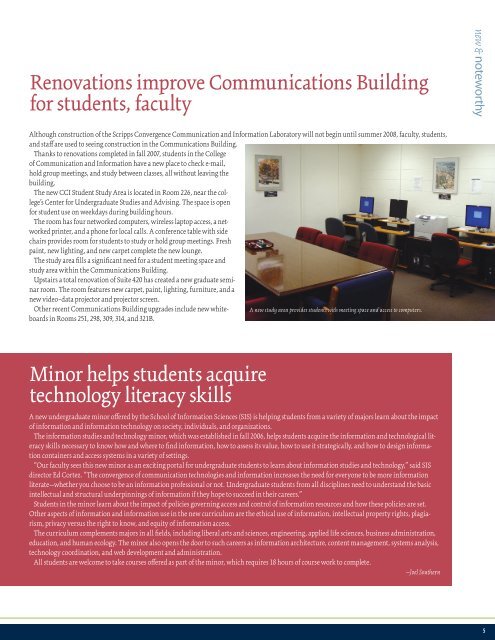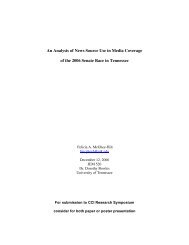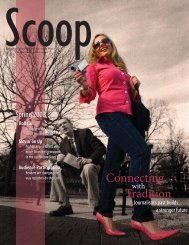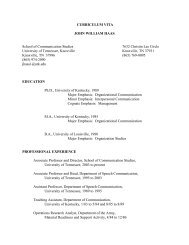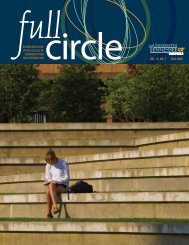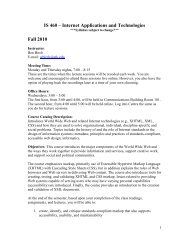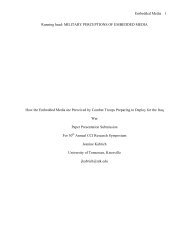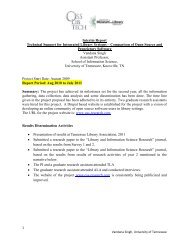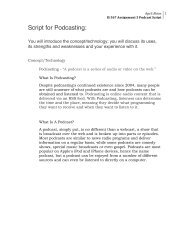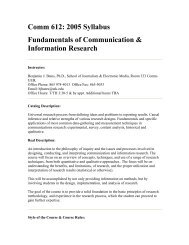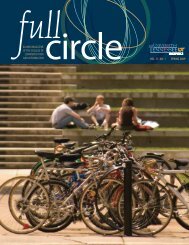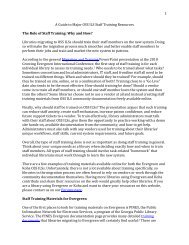new & noteworthy$500,000 Scripps Howard Foundationgrant funds convergence labStudents will see big changes happening on the fourth floor <strong>of</strong> the<strong>Communication</strong>s Building over the next year-and-a-half thanks to agenerous gift from the Scripps Howard Foundation.<strong>The</strong> $500,000 grant, which was awarded to the college last fall, will fundconstruction <strong>of</strong> a new media laboratory for use by <strong>College</strong> <strong>of</strong> <strong>Communication</strong>and <strong>Information</strong> students.<strong>The</strong> facility, which will be called the E.W. Scripps Convergence <strong>Communication</strong>and <strong>Information</strong> Laboratory, will be designed to help studentsprepare to work in a communication and information industry thatis becoming increasingly more digital and interactive.“We are very grateful to the Scripps Howard Foundation for this transformationalgift. It will provide our students with a world-class teachingand learning facility that will allow us to push the envelope with respectto communication and information convergence education,” said DeanMike Wirth.Construction <strong>of</strong> the state-<strong>of</strong>-the-art lab, which will occupy nearly 4,000square feet <strong>of</strong> space in the <strong>Communication</strong>s Building, is set to begin insummer <strong>2008</strong>.“<strong>The</strong> internet and other emerging electronic platforms are revolutionizinghow people are consuming media,” said Judith G. Clabes, presidentand chief executive <strong>of</strong>ficer <strong>of</strong> the Scripps Howard Foundation. “Consequently,much <strong>of</strong> our focus at the Scripps Howard Foundation has beenon helping schools <strong>of</strong> communication across the country prepare theirstudents to work in our ever-evolving industry. We view our growingpartnership with the University <strong>of</strong> Tennessee as a wise investment in theeducation <strong>of</strong> future media and communications pr<strong>of</strong>essionals.”<strong>The</strong> Scripps Howard Foundation is the philanthropic arm <strong>of</strong> the E.W.Scripps Company, which owns and operates Knoxville-based ScrippsNetworks and the Knoxville News Sentinel newspaper. Scripps Networkscomprises the company’s portfolio <strong>of</strong> national lifestyle television networks,including HGTV, Food Network, DIY Network, Fine Living TVNetwork, and Great American Country. <strong>The</strong> company intends to separateinto two publicly traded corporations by mid-year <strong>2008</strong>—Scripps NetworksInteractive and the E.W. Scripps Company.“Today knowledge <strong>of</strong> new media is vital for those interested in a careerin the field <strong>of</strong> communications,” said John Lansing, president <strong>of</strong> ScrippsNetworks. “My hope is that this new lab will expand the students’ understandingand knowledge which, ultimately, will make them more attractivejob candidates.”Bruce Hartmann, president and publisher <strong>of</strong> the Knoxville News Sentinel,said, “<strong>The</strong> grant for the new media lab at UT demonstrates in a very tangibleway the Scripps Howard Foundation’s determination to help today’sjournalism and communications students get out in front <strong>of</strong> the changesand opportunities in our industry. Managers <strong>of</strong> local and national mediabusinesses will soon be looking to those same students for creative ideasand solutions.”Undergraduates in the college will work individually and in teams onprojects such as creating, producing, managing, and marketing digitalcontent. Work done in the lab will not only meet class requirements, butwill also appear in such platforms as print, broadcast, online, and variousforms <strong>of</strong> mobile media.Students’ work will be accessible to a variety <strong>of</strong> audiences, includingpotential employers.“In the not-so-distant past, the lines <strong>of</strong> different communication andinformation disciplines were very clear,” said Wirth. “Today, with theinternet bringing the disciplines together and creating new ways to communicate,students must be prepared to communicate effectively througha variety <strong>of</strong> channels and across a number <strong>of</strong> different platforms to be successfulin the field.”<strong>The</strong> grant for the media lab is the second commitment that the ScrippsHoward Foundation has made to UT’s <strong>College</strong> <strong>of</strong> <strong>Communication</strong> and<strong>Information</strong>. Earlier the foundation had presented the university witha $50,000 gift to fund the Tennessee Journalist Web Journalism Project,which connects UT journalism and electronic media students with topweb journalism pr<strong>of</strong>essionals.<strong>The</strong> Scripps Howard Foundation’s mission is to advance the cause <strong>of</strong>a free press through support <strong>of</strong> excellence in journalism, quality journalismeducation, and pr<strong>of</strong>essional development. <strong>The</strong> foundation helpsbuild healthy communities and improve the quality <strong>of</strong> life through support<strong>of</strong> sound educational programs, strong families, vital social services,enrichment <strong>of</strong> the arts and culture, and inclusive civic affairs, with a specialcommitment to the communities in which Scripps does business.Scripps HowardFoundation4 UT <strong>College</strong> <strong>of</strong> <strong>Communication</strong> and <strong>Information</strong> Full circle <strong>Spring</strong> <strong>2008</strong>
Renovations improve <strong>Communication</strong>s Buildingfor students, facultynew & noteworthyAlthough construction <strong>of</strong> the Scripps Convergence <strong>Communication</strong> and <strong>Information</strong> Laboratory will not begin until summer <strong>2008</strong>, faculty, students,and staff are used to seeing construction in the <strong>Communication</strong>s Building.Thanks to renovations completed in fall 2007, students in the <strong>College</strong><strong>of</strong> <strong>Communication</strong> and <strong>Information</strong> have a new place to check e-mail,hold group meetings, and study between classes, all without leaving thebuilding.<strong>The</strong> new CCI Student Study Area is located in Room 226, near the college’sCenter for Undergraduate Studies and Advising. <strong>The</strong> space is openfor student use on weekdays during building hours.<strong>The</strong> room has four networked computers, wireless laptop access, a networkedprinter, and a phone for local calls. A conference table with sidechairs provides room for students to study or hold group meetings. Freshpaint, new lighting, and new carpet complete the new lounge.<strong>The</strong> study area fills a significant need for a student meeting space andstudy area within the <strong>Communication</strong>s Building.Upstairs a total renovation <strong>of</strong> Suite 420 has created a new graduate seminarroom. <strong>The</strong> room features new carpet, paint, lighting, furniture, and anew video–data projector and projector screen.Other recent <strong>Communication</strong>s Building upgrades include new whiteboardsin Rooms 251, 298, 309, 314, andA new study area provides students with meeting space and access to computers.321B.Minor helps students acquiretechnology literacy skillsA new undergraduate minor <strong>of</strong>fered by the School <strong>of</strong> <strong>Information</strong> Sciences (SIS) is helping students from a variety <strong>of</strong> majors learn about the impact<strong>of</strong> information and information technology on society, individuals, and organizations.<strong>The</strong> information studies and technology minor, which was established in fall 2006, helps students acquire the information and technological literacyskills necessary to know how and where to find information, how to assess its value, how to use it strategically, and how to design informationcontainers and access systems in a variety <strong>of</strong> settings.“Our faculty sees this new minor as an exciting portal for undergraduate students to learn about information studies and technology,” said SISdirector Ed Cortez. “<strong>The</strong> convergence <strong>of</strong> communication technologies and information increases the need for everyone to be more informationliterate—whether you choose to be an information pr<strong>of</strong>essional or not. Undergraduate students from all disciplines need to understand the basicintellectual and structural underpinnings <strong>of</strong> information if they hope to succeed in their careers.”Students in the minor learn about the impact <strong>of</strong> policies governing access and control <strong>of</strong> information resources and how these policies are set.Other aspects <strong>of</strong> information and information use in the new curriculum are the ethical use <strong>of</strong> information, intellectual property rights, plagiarism,privacy versus the right to know, and equity <strong>of</strong> information access.<strong>The</strong> curriculum complements majors in all fields, including liberal arts and sciences, engineering, applied life sciences, business administration,education, and human ecology. <strong>The</strong> minor also opens the door to such careers as information architecture, content management, systems analysis,technology coordination, and web development and administration.All students are welcome to take courses <strong>of</strong>fered as part <strong>of</strong> the minor, which requires 18 hours <strong>of</strong> course work to complete.—Joel Southern5


